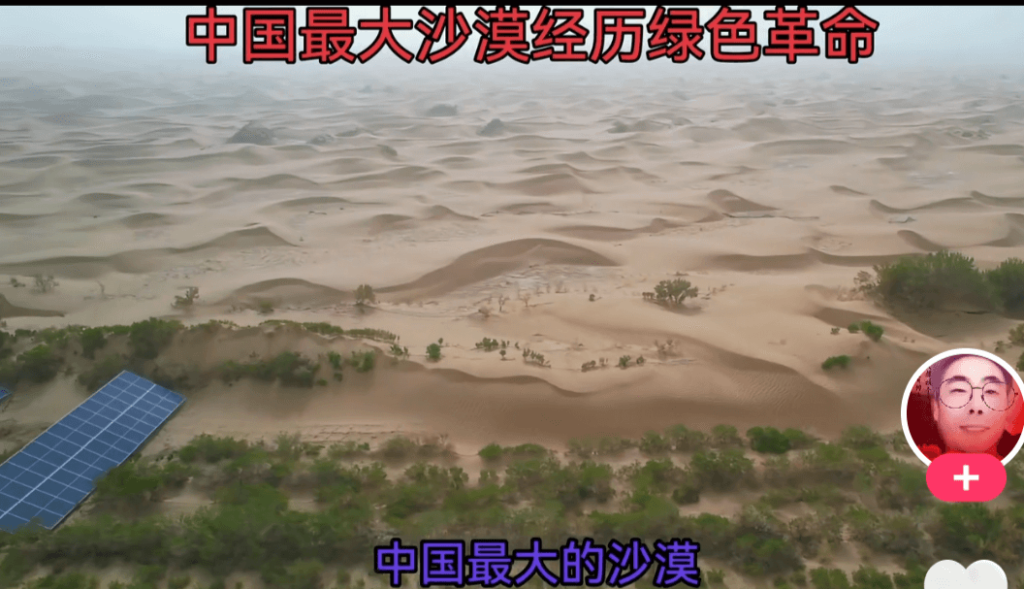这可是人类历史上最伟大的工程之一!2024年11月28号,塔克拉玛干这条中国最大,全球第二的流动沙漠,被我们用绿色防护带圈了起来。
从20世纪70年代起,一代又一代的中国人用了整整40年的努力,终于成功把这片沙漠给包围了。塔克拉玛干沙漠面积33.7 6万平方公里,是国内最大、全球第二的流动沙漠。它的面积比三个韩国还要大,相当于江苏、浙江、福建三个省加起来。而之所以叫它流动沙漠,主要就是因为它会侵蚀周围的土地,又由于不断的扩张,它已经和我国北方的多个沙漠组成了一条沙漠带,严重威胁着西北的生产环境。这些沙子,一到冬天就会顺着风吹向内陆。许多北方城市的沙尘暴大多数都是塔克拉玛干给贡献的。如果放任不管,那么北方的环境就会进一步恶化,将来会让处于沙漠带地区的老百姓可能连种地都没地儿了,家园变沙地那可不是闹着玩的。
而且这还关乎着一带一路的经济战略,新亚欧大陆桥和中巴经济走廊的铁路、公路都要穿过这片沙漠。沙漠如果持续的扩张,那到时候途经的铁路、能源、通讯这些基础设施都会受到威胁。所以不管是为了环境、生态还是经济发展,这个问题都必须要解决。而这个塔克拉玛干无疑就是沙漠中的重中之重。
塔克拉玛干沙漠其实并不缺水,国内的工程师们通过探测发现这里的地下水反而非常的丰富,足足有八十多万亿立方米,这相当于571万个西湖。这个地下水主要是来自附近的冰川和融雪,虽然藏得很深,但偶尔会通过湖泊和地下河现身。而且塔里木盆地内还有一百多条河流能把水渗入地下,于是就围绕着这些地下水资源,一代又一代的治沙人一边种树,一边在沙地上搭起草格子。这些草格子呢就像网一样架在沙地上,往里的草根深扎土壤,防止风把沙子吹抖。这样固定好以后啊,治沙人就通过打井抽地下水的方式,再通过管道把水送到植物根部,对绿植进行灌溉,促进植被的生长。并利用人工湖、湿地这些手段增加水源的生活,形成一个生态循环。
慢慢的草长得越来越密了,沙地也不再跑沙子了,沙漠开始恢复生机,最终我们建立了3046公里的绿色防护带,这就相当于把绿化带从中国上海修到了云南的西双版纳,成功的把沙漠给围住了。
从这一刻开始,塔克拉玛干的面积只会减少,不会再扩张。接下来的几十年里,花草树木、光伏板都会陆续上阵,逐渐把这里打造成一片绿洲。慢慢的以后这里就是良田万顷、麦浪翻滚的农业天堂。
而且这里也是资源宝地,塔里木盆地埋葬的油气资源深埋超过6000米,占据我国陆上超深油气资源量的60%,全球的19%,这就意味着这里未来也是相当有潜力的。
塔克拉玛干沙漠围边合拢,边不仅是人类历史上的巅峰成就,也是独属于咱们中国人的浪漫。此时此刻,我只想吟诗一首,中华儿女多极致,敢叫日月换新天。
One of China’s greatest projects in the 21st century: encircling the Taklamakan Desert! Turn the desert into an oasis.

This is one of the greatest projects in the history of mankind! On November 28th, 2024, the Taklamakan, China’s largest and the world’s second largest flowing desert, was circled by us with a green protective belt.Since the 1970s, generations of Chinese people have worked hard for 40 whole years and finally succeeded in encircling this desert. With an area of 337,600 square kilometers, the Taklamakan Desert is the largest flowing desert in China and the second largest in the world. It is larger than three Koreas, equivalent to the provinces of Jiangsu, Zhejiang and Fujian combined. And the main reason why it is called a mobile desert is that it erodes the land around it, and because of its continuous expansion, it has formed a desert belt with several deserts in the north of China, seriously threatening the productive environment of the northwest. This sand, once winter comes, blows inland with the wind. Most of the dust storms in many northern cities are contributed by the Taklamakan. If left unchecked, then the environment in the north will further deteriorate, and in the future, it will make the people in the desert belt area may not even have land to plant, and it’s no joke to have their homes turned into sand.And this is also related to the economic strategy of the Belt and Road, the New Asia-Europe Continental Bridge and the China-Pakistan Economic Corridor railroads and highways will have to cross this desert. If the desert continues to expand, then the railroad, energy, communications and other infrastructure will be threatened. So whether for the environment, ecology or economic development, this problem must be solved. And this Taklamakan is undoubtedly the desert in the top priority.Taklamakan Desert is not actually a lack of water, domestic engineers through the detection found that the groundwater here is very rich, more than eighty trillion cubic meters, which is equivalent to 5.71 million West Lake. This underground water mainly comes from the nearby glaciers and melting snow, although hidden very deep, but occasionally through the lakes and underground rivers appear. Moreover, there are more than a hundred rivers in the Tarim Basin that can seep water into the ground, so around these groundwater resources, generation after generation of people who treat sand planted trees while building grass lattices in the sand. These grass lattice it is like a net on the sand, to the inside of the grass roots deep in the soil, to prevent the wind from blowing the sand shaking. After this fixed ah, sand people will pump groundwater by drilling wells, and then through the pipeline to the roots of the plant, the green plants for irrigation, to promote the growth of vegetation. And the use of artificial lakes, wetlands and these means to increase the life of the water source, the formation of an ecological cycle.Slowly the grass grows denser and denser, the sand no longer runs away from the sand, the desert begins to regain its vitality, and eventually we established a 3,046-kilometer green belt, which is equivalent to repairing the green belt from Shanghai, China, to Xishuangbanna, Yunnan Province, successfully enclosing the desert.From this moment on, the area of the Taklamakan will only decrease, not expand. In the next few decades, flowers, plants, trees and photovoltaic panels will be put on the ground one after another, gradually turning this place into an oasis. Slowly, it will be an agricultural paradise with thousands of hectares of good land and waves of wheat.And here is also a treasure of resources, the Tarim Basin buried oil and gas resources buried more than 6,000 meters deep, occupying 60% of China’s onshore ultra-deep oil and gas resources, the world’s 19%, which means that the future of this place is also quite potential.Taklamakan Desert surrounded by the edge of the closing, the edge is not only the pinnacle of achievement in human history, but also belongs to the romance of our Chinese people alone. At this moment, I just want to recite a poem, Chinese children more extreme, dare to call the sun and moon a new day.
